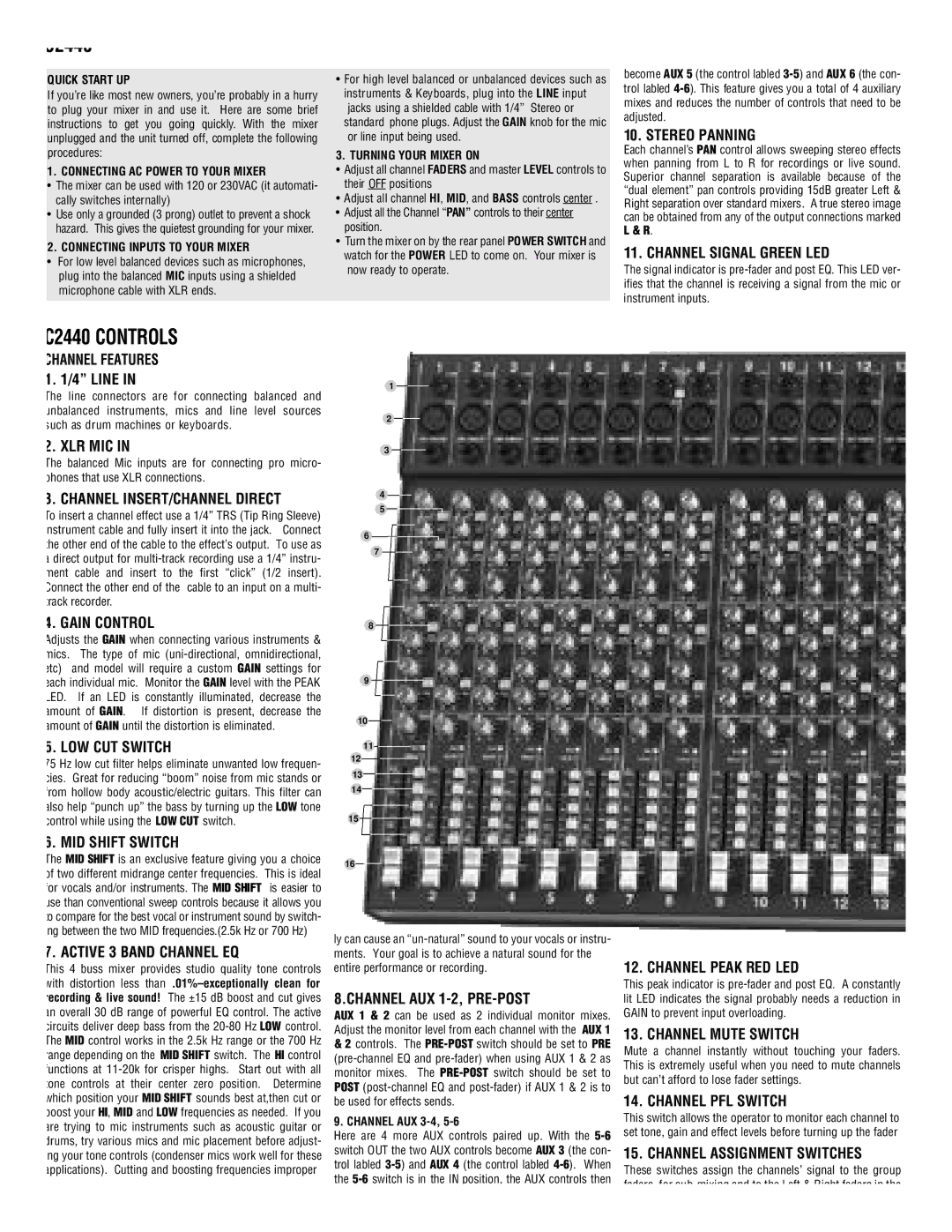
C2440
QUICK START UP
If you’re like most new owners, you’re probably in a hurry to plug your mixer in and use it. Here are some brief instructions to get you going quickly. With the mixer unplugged and the unit turned off, complete the following procedures:
1.CONNECTING AC POWER TO YOUR MIXER
•The mixer can be used with 120 or 230VAC (it automati- cally switches internally)
•Use only a grounded (3 prong) outlet to prevent a shock hazard. This gives the quietest grounding for your mixer.
2.CONNECTING INPUTS TO YOUR MIXER
•For low level balanced devices such as microphones, plug into the balanced MIC inputs using a shielded microphone cable with XLR ends.
•For high level balanced or unbalanced devices such as instruments & Keyboards, plug into the LINE input jacks using a shielded cable with 1/4” Stereo or standard phone plugs. Adjust the GAIN knob for the mic or line input being used.
3.TURNING YOUR MIXER ON
•Adjust all channel FADERS and master LEVEL controls to their OFF positions
•Adjust all channel HI, MID, and BASS controls center .
•Adjust all the Channel “PAN” controls to their center position.
•Turn the mixer on by the rear panel POWER SWITCH and watch for the POWER LED to come on. Your mixer is now ready to operate.
become AUX 5 (the control labled
10. STEREO PANNING
Each channel’s PAN control allows sweeping stereo effects when panning from L to R for recordings or live sound. Superior channel separation is available because of the “dual element” pan controls providing 15dB greater Left & Right separation over standard mixers. A true stereo image can be obtained from any of the output connections marked
L & R.
11. CHANNEL SIGNAL GREEN LED
The signal indicator is
C2440 CONTROLS
CHANNEL FEATURES
1. 1/4” LINE IN
The line connectors are for connecting balanced and unbalanced instruments, mics and line level sources such as drum machines or keyboards.
2. XLR MIC IN
The balanced Mic inputs are for connecting pro micro- phones that use XLR connections.
3. CHANNEL INSERT/CHANNEL DIRECT
To insert a channel effect use a 1/4” TRS (Tip Ring Sleeve) nstrument cable and fully insert it into the jack. Connect the other end of the cable to the effect’s output. To use as a direct output for
4. GAIN CONTROL
Adjusts the GAIN when connecting various instruments & mics. The type of mic
5. LOW CUT SWITCH
75 Hz low cut filter helps eliminate unwanted low frequen- cies. Great for reducing “boom” noise from mic stands or from hollow body acoustic/electric guitars. This filter can also help “punch up” the bass by turning up the LOW tone control while using the LOW CUT switch.
6. MID SHIFT SWITCH
The MID SHIFT is an exclusive feature giving you a choice of two different midrange center frequencies. This is ideal for vocals and/or instruments. The MID SHIFT is easier to use than conventional sweep controls because it allows you to compare for the best vocal or instrument sound by switch- ng between the two MID frequencies.(2.5k Hz or 700 Hz)
7. ACTIVE 3 BAND CHANNEL EQ
This 4 buss mixer provides studio quality tone controls with distortion less
recording & live sound! The ±15 dB boost and cut gives an overall 30 dB range of powerful EQ control. The active circuits deliver deep bass from the
1
2
3
4
5
6![]()
![]()
7
8
9
10
11
12
13
14
15
16
ly can cause an
8.CHANNEL AUX 1-2, PRE-POST
AUX 1 & 2 can be used as 2 individual monitor mixes. Adjust the monitor level from each channel with the AUX 1
&2 controls. The
9. CHANNEL AUX 3-4, 5-6
Here are 4 more AUX controls paired up. With the
12. CHANNEL PEAK RED LED
This peak indicator is
13. CHANNEL MUTE SWITCH
Mute a channel instantly without touching your faders. This is extremely useful when you need to mute channels but can’t afford to lose fader settings.
14. CHANNEL PFL SWITCH
This switch allows the operator to monitor each channel to set tone, gain and effect levels before turning up the fader
